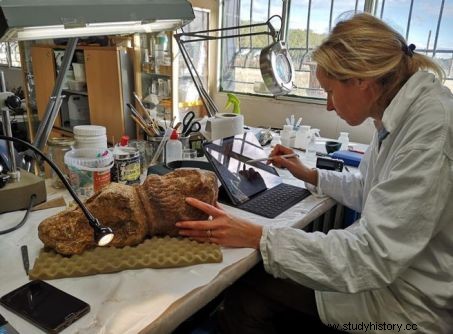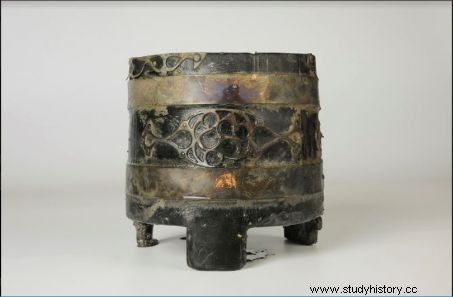Brittany still holds amazing treasures. Carved in stone, rare Gallic statues from the 1 st century BC have just been identified by teams from Inrap (National Institute for Preventive Archaeological Research) , during archaeological excavations carried out in the Côtes-d'Armor.

Figure of a Gallic aristocrat with torque, found buried in a pit of the I st century before our era, on the site of Trémuson, in Brittany.
Wearing a neat beard and mustache, the neck girded with a torque - a rigid gold necklace - for one of them, four remarkable statues representing Gallic aristocrats, were recently unearthed during preventive archaeological excavations (Inrap) carried out in Trémuson, in the Côtes-d'Armor. Deliberately buried (or abandoned) on the 1 st century before our era, these busts about forty centimeters high were discovered respectively in a rectangular pit "face against the ground" for one, and a few days later, at the bottom of a well, for the other three.

Cleaning and restoration of the Gallic statues of Trémuson. © Stephanie Hurtin / Inrap
Exceptional discoveries
All these remarkable finds appeared in "the residential space of a Gallic farm founded in the 4 th century before our era [...] in the place called la Morandais in Trémuson, in the ancient city of the Osismes (Osismii)” , an Armorican Celtic people, explains Stephane Bourne, head of the excavations, in a press release issued by Inrap. Until now, only about thirty of these types of statues were known in all of Celtic Europe. In March 2019, Sciences et Avenir had also presented one of the most famous of them, discovered in Paule, about 70 km from the Costa Rican site. That of a bard at the lyre dated from the end of the II th century BCE, hewn from metahornblendite, a pale green metamorphic rock.

Wooden bucket ringed with wrought bronze, found at the bottom of a well in Trémuson (Côte-d'Armor). © Emmanuelle Collado / Inrap
In addition to these precious busts, which are just as unusual, a magnificent ceremonial bucket circled in bronze enhanced with elegant spiral motifs, was also unearthed on the site of Trémuson, recalling the mastery of metals by the Gallic bronzers. They indeed made remarkable culinary utensils intended for aristocratic meals. "The bucket was to be used during banquets or ceremonies […]. We also found ceramics in excellent condition and amphoras from Italy and Spain, true witnesses of the commercial circuits of the time" , said Claude Le Potier, interregional director of Inrap Grand Ouest, who spoke in the columns of the daily Le Parisien . Great consumers of wine, the Gauls had indeed made this drink one of the flagship commodities of their trade.
